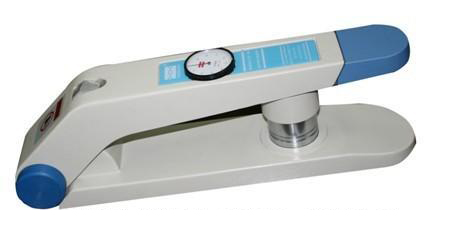Site: Home > Home > News and events
Textile softness test is a requirement for some special material textiles, especially for types of textiles such as baby products and pyjamas and underwear, which have clear testing standards for their softness, currently on the market for testing textile softness test textiles are mainly: touch by hand (commonly known as touch test), rigid and flexible tester, stiffness tester, textile softness tester, etc., this article ZD for you ZD introduces the following softness testers for textiles.
Rigid and flexible tester.
Relevant standards.
JIS L 1076, JAPAN TAPPI No.34, ASTM D2923-06
Uses/benefits.
This tester is suitable for evaluating the stiffness and flexibility of textile products (especially silk, cotton and chemical fibres), paper products such as tissue paper and plastic films of various nature. The tester is manufactured in accordance with the Japanese Industrial Standard JIS L 1096 General Test Method for Textiles (stiffness and flexibility: E method).
The test piece is laid out on a test bench with a fine slot and the softness of the test piece is evaluated by measuring the resistance (g) that occurs when the blade on the tester presses the piece into the slot to a certain depth (8 mm).
Unlike other softness measurement methods, this method is characterised by the fact that the test piece slides on the test bench several times as it is pressed into the fine groove, so the measured value is a combination of the sliding friction and the resistance force (softness) at the time of pressing in.

Remark.
*Once the test piece has been installed, simply pressing the start button makes the measurement operation simple and quick.
*The calibration sequence shown on the display makes calibration easy and accurate.
*The measured values and the average of any number of returns can be printed out on the printer.
Instrument features.
The infra-red beam forms an "invisible" test incline, replacing the traditional tangible incline, enabling contactless testing and overcoming the problem of the accuracy of the measurement being affected by the twisting of the specimen held up by the incline. It also makes it possible to adjust the angle of inclination of the measurement.
The automatic inspection system overcomes the shortcomings of visual inspection and increases the resistance to interference. The automatic lifting and lowering of the specimen platen guarantees the accuracy and consistency of the positioning of the platen and the specimen and improves the working efficiency.
Technical parameters.
1. Measuring angle of the instrument: 41°30', 43°, 45° adjustable
2. Extending length range: 0.5cm20cm (special requirements can be made at the time of ordering)
3. Resolution of numerical display: 0.01cm
4.Measurement accuracy: ±1%
5. Specimen size: 2.5cm x 20cm
6. Working platform specification: 5cm×20cm
7. Specimen platen size: 2.5cm x 20cm
8. Specimen platen pushing speed: 0.3~0.5 cm/s (special requirements can be proposed at the time of ordering)
9. Rated power: 45W
10.Power supply: single phase 220V 50Hz
11. Volume of main machine: 425mm×250mm×380mm
12.Mainframe weight: 16.5Kg
Scope of application.
The softness of the material is objectively evaluated by testing its softness value. It is suitable for testing the softness of fabrics, textiles, non-woven fabrics, toilet paper products, leather and other soft materials in sheet form. It is also possible to test the elasticity/viscoelasticity/plasticity, top breakage, compressibility, basis weight and thickness of the specimen using different accessories.
Test significance.
1、To ensure the quality of the product during production;
2、Optimisation of product properties;
3. To ensure quality control of products of the same grade in the production process.
Copyright 2022:Qinsun Instruments Co., Limited
High-end textile tester supplier Email:info@qinsun-lab.com | Textile Testing Equipment pdf | Tel:021-67800179 |